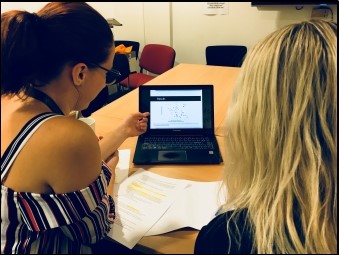by Emily Kyle
in2science UK is an award-winning charity which matches school students from disadvantaged backgrounds to research placements, giving them the opportunity to pursue their interests in STEM subjects. This summer, The Oxford Scientist, was pleased to provide free copies of the magazine to students who came to the University of Oxford. Two of these students – Emily Kyle and Judahne Medley – have written blogs to share their experience of their exciting research placements. Emily was a finalist and Judahne the overall winner of the in2science blog competition.
Find out more about the work in2science do by visiting their website: http://in2scienceuk.org/
At the start of my work experience I was given the opportunity to read, analyse and present a scientific paper to the Breathe Oxford team, with whom I worked with for the week. I presented the paper in the group’s Journal Club, which is a monthly meeting in which they discuss recently published research to inform their own work (and eat cake!).
The title of the paper was “Discrepancies between dimensions of interoception in autism: implications for emotion and anxiety”. I chose this because of my interest in mental health and how it may affect other people. My supervisor, Lucy Marlow, supported me in reading through the paper and analysing the different points to bring up in the presentation.
The paper concentrated on Sarah Garfinkel’s dimensions of interoception, which is something that the Breathe Oxford team is also researching. Garfinkel suggests there are 3 different sub-types of interoception. Interoception itself is the ability to detect and perceive fluctuations in one’s internal physiological state. From this Garfinkel suggests there is:
- Interoceptive accuracy, which is the objective assessment of performance on behavioural tasks
- Interoceptive sensibility, which is the confidence in one’s own interoceptive decisions
- Interoceptive awareness, which is the metacognitive insight into one’s own interoceptive ability
The paper suggested that differences in interoceptive dimensions played a role in the variance in emotional processing observed between an Autism Spectrum Conditions (ASC) group and a healthy control group. It was interesting to explore the mechanisms that underlie the differences between people.
I was really proud to present my finished presentation to the group. I read from graphs and even explained what a heartbeat discrimination task was! We discussed the pros and cons of the protocols and analyses used in the study as a group, helping to inform the Breathe Oxford team which techniques would be useful for their own studies in respiration. This was all followed by a well-deserved slice of brain cake!

All of this was new to me but I enjoyed reading the paper and learning about things I didn’t even know were possible. The brain has always fascinated me, and now with everything I have taken from this experience, I am excited to look further into Neuroscience and maybe even write my own paper one day!





